Hi All,
I'm having trouble finding any references in the literature for the structures I'm seeing on the Ha and SII exposures of Beta Cen (Hadar) on the wide angle panorama of the region [1]
[1] https://www.astrobin.com/gcqtmj/

Both features turn out to be complex structures upon a close look in Ha (most prominent) and SII (some parts of the main condensation still visible), but not in OIII (in which the light from the main star getting trough the filter is the strongest) [2, 3]:
[2] https://www.astrobin.com/ojtcmx/C/
[3] https://www.astrobin.com/8gpw0u/
The annotated Ha exposure from [2] is given below:
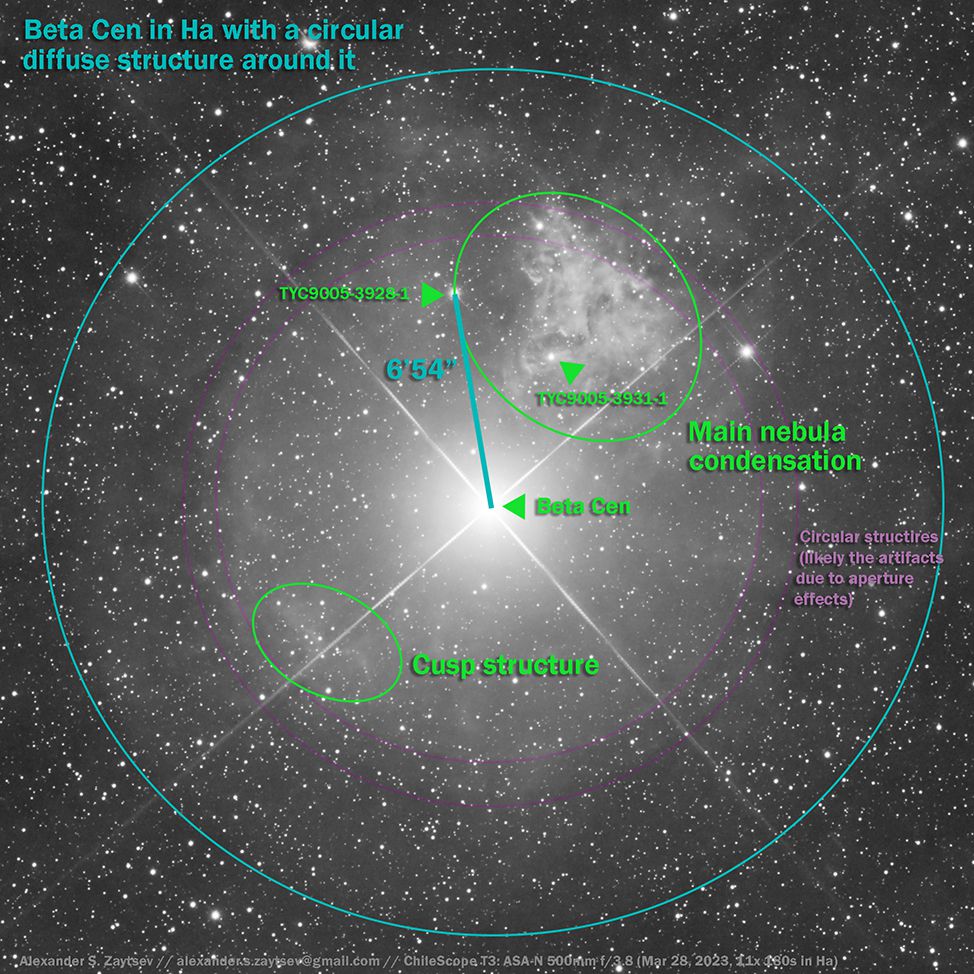
The annotated SII exposure from [2] is given below:

The annotated OIII exposure from [2] serving the purpose of understanding the light scattering patterns in the scene is given below:
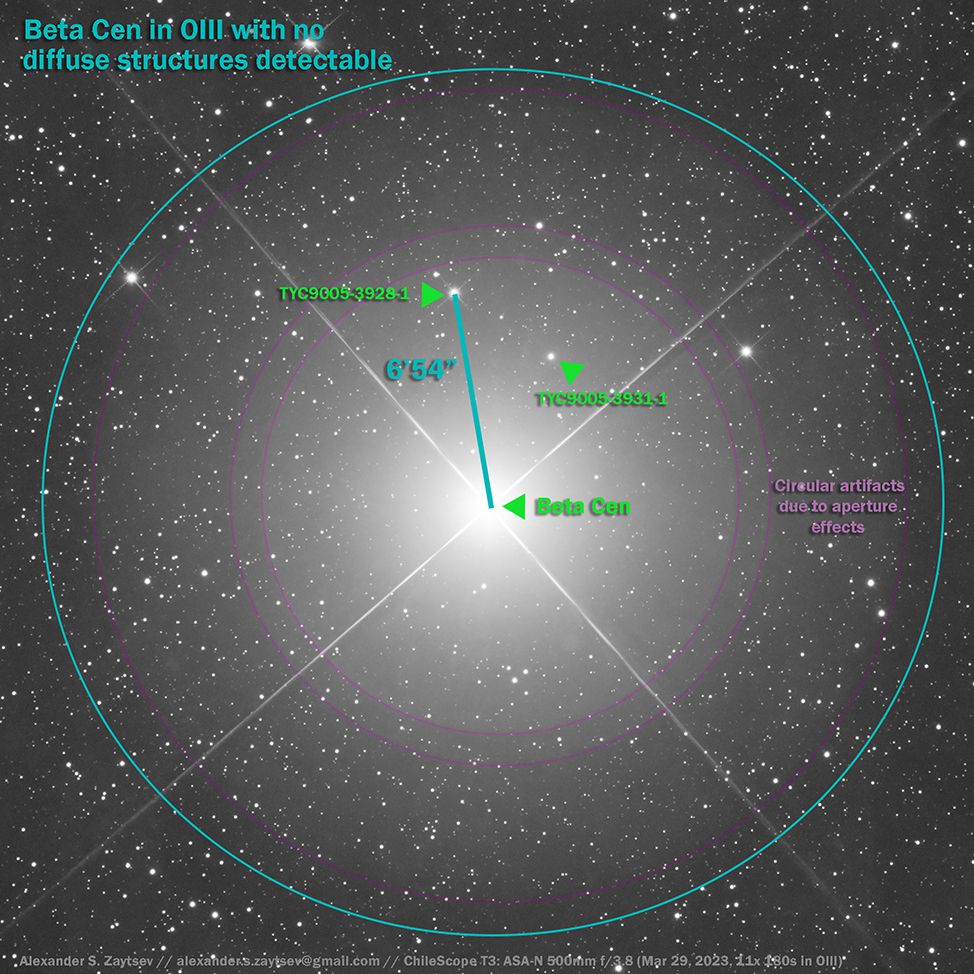
If anyone knows catalog numbers for any of these diffuse structures, or imaged them before, or seen them referenced in some publications, could you please let me know?
Any information on these is highly appreciated!
Cheers,
Alex.
|
You cannot like this item. Reason: "ANONYMOUS".
You cannot remove your like from this item.
Editing a post is only allowed within 24 hours after creating it.
You cannot Like this post because the topic is closed.
Hi @Gary Imm , @Marcel Drechsler , @Xavier Strottner ,
As experts in imaging of small and otherwise challenging / obscure DSOs, have you ever encountered these structures by any chance?
I can't even call this one "small" as the main condensation is 7' across, and the only obscure feature of these structures is that they are only visible with enough contrast in Ha, and with reflecting telescopes - only while pointing directly at the main star (Beta Car), as otherwise the parasitic light takes it all. So, I suspect someone must have seen it before.
Thanks for your help in advance,
Cheers,
Alex.
|
You cannot like this item. Reason: "ANONYMOUS".
You cannot remove your like from this item.
Editing a post is only allowed within 24 hours after creating it.
You cannot Like this post because the topic is closed.
Note that there is a hint of this structure on DSS2 color survey but since the central star is so overexposed there it can be easily mistaken as some sort of optical artifact:

The DSS2 Color image as an aligned overlay for Ha exposure from [2] is give below, it is unmistakably the hint of the same structure:
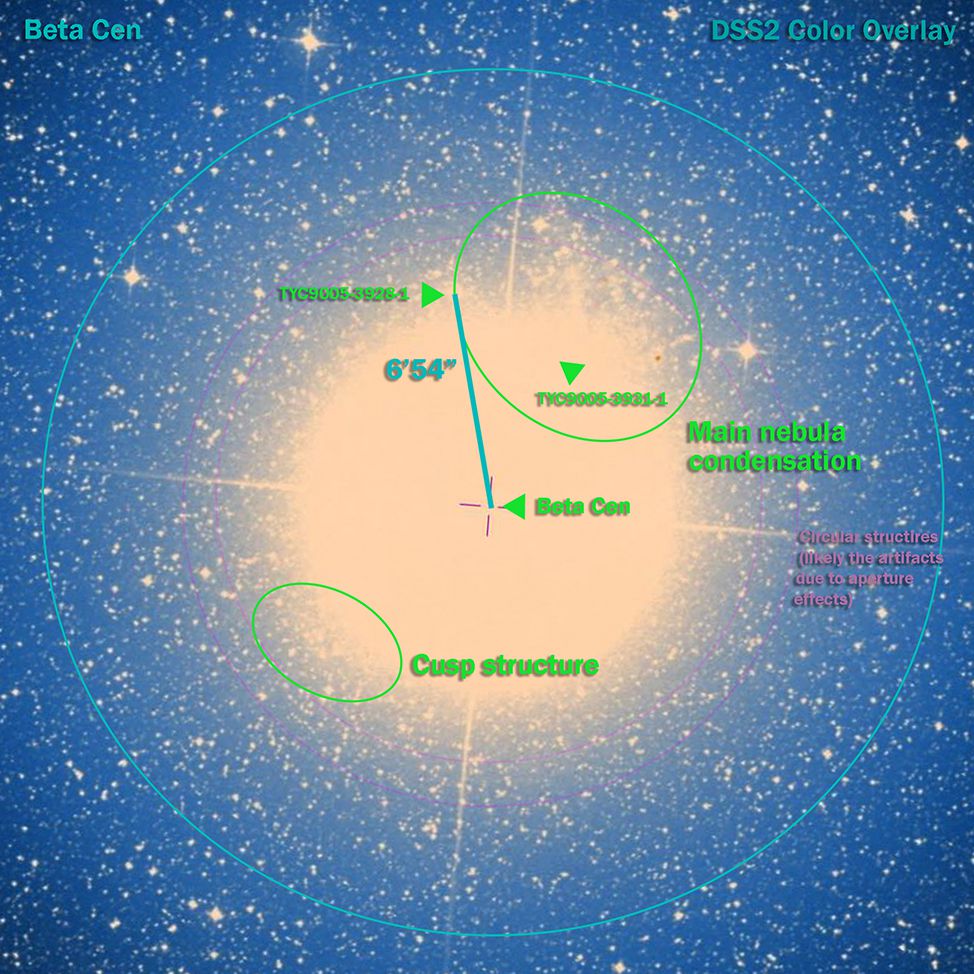 |
You cannot like this item. Reason: "ANONYMOUS".
You cannot remove your like from this item.
Editing a post is only allowed within 24 hours after creating it.
You cannot Like this post because the topic is closed.
Alexandr Zaytsev:
Hi @Gary Imm , @Marcel Drechsler , @Xavier Strottner ,
As experts in imaging of small and otherwise challenging / obscure DSOs, have you ever encountered these structures by any chance?
I can't even call this one "small" as the main condensation is 7' across, and the only obscure feature of these structures is that they are only visible with enough contrast in Ha, and with reflecting telescopes - only while pointing directly at the main star (Beta Car), as otherwise the parasitic light takes it all. So, I suspect someone must have seen it before.
Thanks for your help in advance,
Cheers,
Alex.
Alexandr - great work on imaging these very challenging objects! I have only focused on objects which are visible to me from my Texas location, so this one (at -64) I have never studied or documented.
|
You cannot like this item. Reason: "ANONYMOUS".
You cannot remove your like from this item.
Editing a post is only allowed within 24 hours after creating it.
You cannot Like this post because the topic is closed.
Greetings to all and especially to you Alex!
I am always very glad when astrophotos are analysed extensively, because only in this way new exciting discoveries can be made.
Let's see what the object in your image is all about.
Beta Centauri is a star of spectral class B1III, which means it has a surface temperature of 10000 to 30000 Kelvin.
These enormous temperatures of this blue giant star are sufficient to ionise surrounding hydrogen gas.
Hydrogen gas is abundant in the region around Beta Centauri, which is why a thin veil has formed around the star as HII.
The best representation of this process is provided by the infrared data from the WISE satellite:

Interesting here that there is a very strong, infrared source at about four o'clock of Beta Centauri, which coincides with the position of your "nebula X".
Here is a false-colour representation of various infrared bands:

If we take a closer look at the small, extremely bright nebula beyond beta Cen, we notice that there is a small star right in its centre, around which fine arc segments also extend. This star is most likely the source of your nebula.
A look at the star's data also reveals why the nebula is so bright and conspicuous. The star is a real monster - a star of the spectral class OB+e and thus much hotter than beta Cen itself with a surface temperature of over 44000 Kelvin.
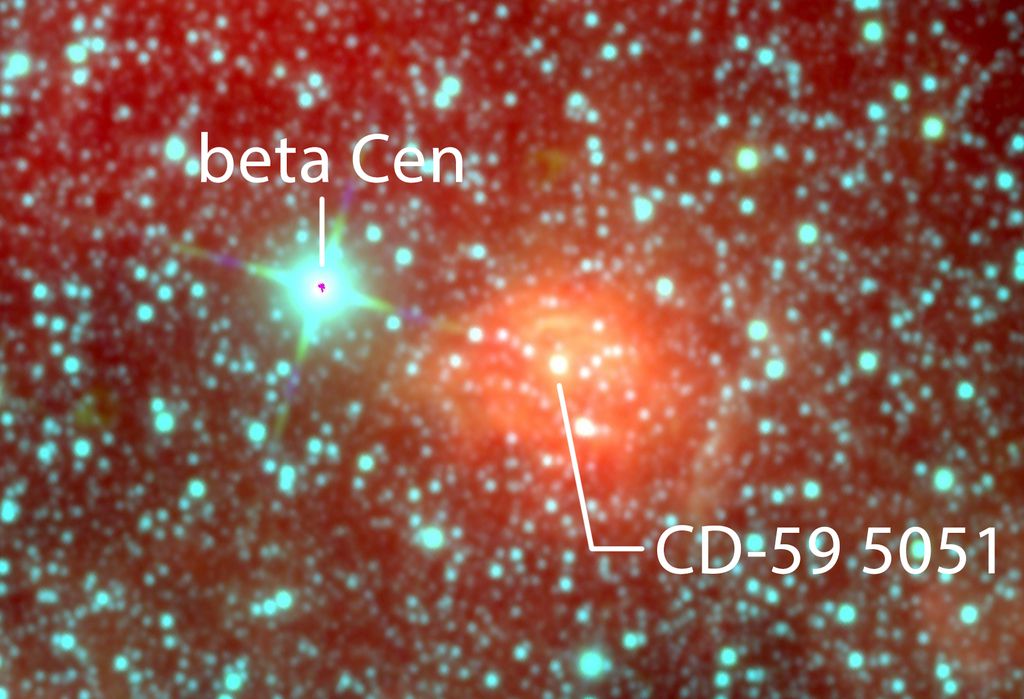
Here is a high-resolution image of CD-59 5051 (Vista survey).
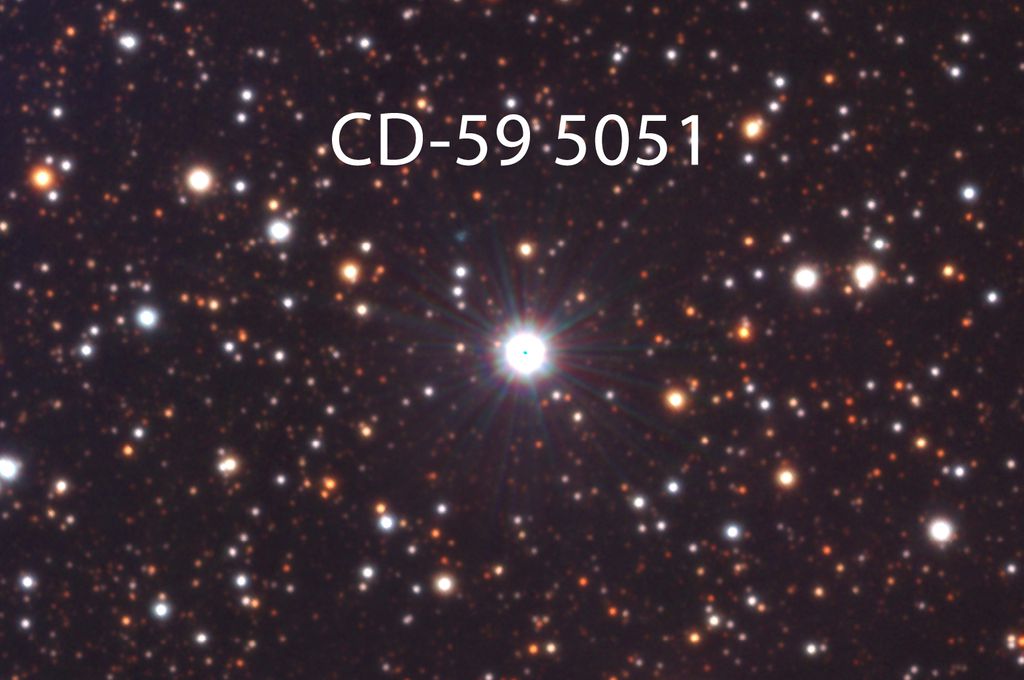
The distance data from Gaia to both stars are fairly accurate:
Distance beta Cen: 120 parsecs
Distance CD-59 5051: 2850 parsecs
Your nebula is therefore far behind beta Cen and has no physical connection to it.
***
But the interesting thing for you should be that I could not find any official reference to this small nebula, which I would call "ionised interstellar material". Also, your H-alpha image is the first to show this nebula in its entirety - congratulations!
I hope I was able to shed some light on the case.
Marcel
|
You cannot like this item. Reason: "ANONYMOUS".
You cannot remove your like from this item.
Editing a post is only allowed within 24 hours after creating it.
You cannot Like this post because the topic is closed.
Gary Imm:
Alexandr Zaytsev:
Hi @Gary Imm , @Marcel Drechsler , @Xavier Strottner ,
As experts in imaging of small and otherwise challenging / obscure DSOs, have you ever encountered these structures by any chance?
I can't even call this one "small" as the main condensation is 7' across, and the only obscure feature of these structures is that they are only visible with enough contrast in Ha, and with reflecting telescopes - only while pointing directly at the main star (Beta Car), as otherwise the parasitic light takes it all. So, I suspect someone must have seen it before.
Thanks for your help in advance,
Cheers,
Alex.
Alexandr - great work on imaging these very challenging objects! I have only focused on objects which are visible to me from my Texas location, so this one (at -64) I have never studied or documented.
Thank you very much, @Gary Imm for your reply and kind words! I myself is the Northern Hemisphere dweller and never been more to the lower latitudes than Florida Keys and never done any proper observations with equipment South of New York (but this may change after the 2024 Total Solar Eclipse  ). So, it is also a tribute to Chilescope ( @chilescope ) capabilities that allows such level of remote astrophotography to be made using their instruments. ). So, it is also a tribute to Chilescope ( @chilescope ) capabilities that allows such level of remote astrophotography to be made using their instruments.
Clear skies! It is always a pleasure to follow your work!
|
You cannot like this item. Reason: "ANONYMOUS".
You cannot remove your like from this item.
Editing a post is only allowed within 24 hours after creating it.
You cannot Like this post because the topic is closed.
Marcel Drechsler:
The best representation of this process is provided by the infrared data from the WISE satellite:
Hi @Marcel Drechsler !
Thanks a lot for looking into this, and I knew you would know where to look precisely to find it in the surveys! I had no idea that WISE survey is such a high resolution guide to the Ha structures of all kinds. (I shall be using it regularly from now on "in search of the place where to dig"  Vista survey looks pretty useful too.) Vista survey looks pretty useful too.)
The "main condensation" ("nebula X") sure looks mighty impressive in the infrared especially at 2.9 kpc distance!
I did suspect that the circular structure at about 7'-11' radius from Beta Cen might be actually physically associated with it, but the "nebula X" could be and overlap or something from a distant background, and the CD-59 5051 (TYC9005-3931-1) star might be the host star for that nebula - thanks for confirming it.
There are also four molecular clouds that are close enough to Beta Cen (thanks to @Ben for pointing those out) to contribute to some of the "darker features" of the circular structure around Beta Cen, but it is not yet clear to what extent:
[MC1] https://simbad.cds.unistra.fr/simbad/sim-id?Ident=%4013437328&Name=%5bMML2017%5d%201279&submit=submit
[MC2] https://simbad.cds.unistra.fr/simbad/sim-id?Ident=%4013443312&Name=%5bMML2017%5d%207264&submit=submit
[MC3] https://simbad.cds.unistra.fr/simbad/sim-id?Ident=%4013442402&Name=%5bMML2017%5d%206354&submit=submit
[MC4] https://simbad.cds.unistra.fr/simbad/sim-id?Ident=%4013443102&Name=%5bMML2017%5d%207054&submit=submit
I will endeavor to incorporate the WISE survey data into the comparison plots just to see what else might align in the Ha and SII images with it.
It is very exiting indeed that this "nebula X" seem to not even to have a name. Now that its shape is fully revealed in the optical range it feels like it should;-)
If you know someone with access to a spectra-coronagraph with large enough field of view to fit this whole scene in, maybe they can be persuaded to study this object further.
Thanks once again and clear skies!
Cheers,
Alex.
|
You cannot like this item. Reason: "ANONYMOUS".
You cannot remove your like from this item.
Editing a post is only allowed within 24 hours after creating it.
You cannot Like this post because the topic is closed.
Me again ;-)
The slightly visible ring around beta Centaurus is not a single object, but a large-scale system of cosmic dust and very compact molecular clouds. I was able to determine some stars within the dust formations and I think that the whole structure, just like your Nebula X, is located at a distance of about 2500 parsecs and is also spatially immensely separated from beta Centaurus.
 |
You cannot like this item. Reason: "ANONYMOUS".
You cannot remove your like from this item.
Editing a post is only allowed within 24 hours after creating it.
You cannot Like this post because the topic is closed.
|
Wow, this is an amazing post. I'll keep my eyes on it. Discovering a new nebula (or at least making note of it first) is excited.
|
You cannot like this item. Reason: "ANONYMOUS".
You cannot remove your like from this item.
Editing a post is only allowed within 24 hours after creating it.
You cannot Like this post because the topic is closed.
@Marcel Drechsler , that would be even more remarkable coincidence because that ring structure appears to be well centered on Beta Cen with probably ~10% tolerance, yet it could be that the aperture light scattering circles are actually making that false impression, and most of that large structure isn't that symmetrical at all. I guess I will have to attempt some sort of continuum subtraction to see what shape it actually is.
Thanks for your continuing interest in this object)
|
You cannot like this item. Reason: "ANONYMOUS".
You cannot remove your like from this item.
Editing a post is only allowed within 24 hours after creating it.
You cannot Like this post because the topic is closed.
|
Btw "Ghost of Hadar" is a very apt name considering it is invisible in Oiii.
|
You cannot like this item. Reason: "ANONYMOUS".
You cannot remove your like from this item.
Editing a post is only allowed within 24 hours after creating it.
You cannot Like this post because the topic is closed.
Btw "Ghost of Hadar" is a very apt name considering it is invisible in Oiii.
If it were invisible in SII as well, I would have promoted it to a full-fledged spectre  |
You cannot like this item. Reason: "ANONYMOUS".
You cannot remove your like from this item.
Editing a post is only allowed within 24 hours after creating it.
You cannot Like this post because the topic is closed.
Hi @Marcel Drechsler !
It turns out the traces of these nebulae (at least the main condensation / Nebula X) are actually visible in RGB, but only in the R channel, and with > 1h integral exposure:


Now also published under
[1] https://www.astrobin.com/ojtcmx/L/
[2] https://www.astrobin.com/ojtcmx/M/
So, the potential for performing the meaningful continuum subtraction for Ha increases  |
You cannot like this item. Reason: "ANONYMOUS".
You cannot remove your like from this item.
Editing a post is only allowed within 24 hours after creating it.
You cannot Like this post because the topic is closed.
Just for the record, more Ha and OIII data was obtained for the Beta Cen and associated "Ghost of Hadar" nebula in April using Riccardi-Honders RH200 D = 200mm f/3 (Telescope #5) of Chilescope, with which a successful redirection of the outer part of scattered light halo was moved away from the main scene by placing it off axis of the FOV [3], [4]:
[3] https://www.astrobin.com/mlnenb/B/
[4] https://www.astrobin.com/mlnenb/F/
[5] https://www.astrobin.com/mlnenb/E/
No additional structure releveled by these wide FOV images, yet a fair amount of details visible on these as well, and even a hint of a "cusp" structure on the opposite side of Beta Cen from the "Ghost" nebula is visible in [5].
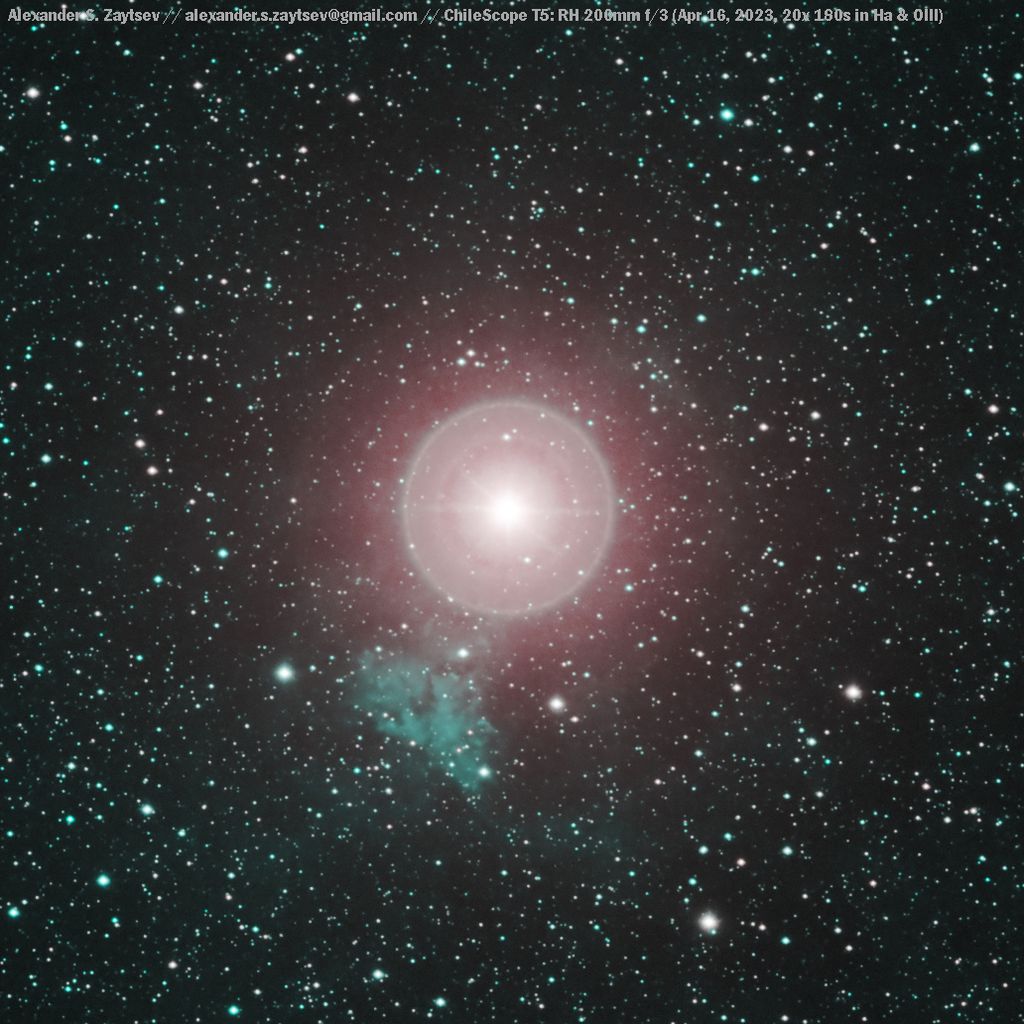 |
You cannot like this item. Reason: "ANONYMOUS".
You cannot remove your like from this item.
Editing a post is only allowed within 24 hours after creating it.
You cannot Like this post because the topic is closed.
Great to see such interesting multi-spectrum detective work at play, thanks @Marcel Drechsler for helping out on this astro journey with your experience of databases and astrophysical processes.  |
You cannot like this item. Reason: "ANONYMOUS".
You cannot remove your like from this item.
Editing a post is only allowed within 24 hours after creating it.
You cannot Like this post because the topic is closed.
to create to post a reply.

















